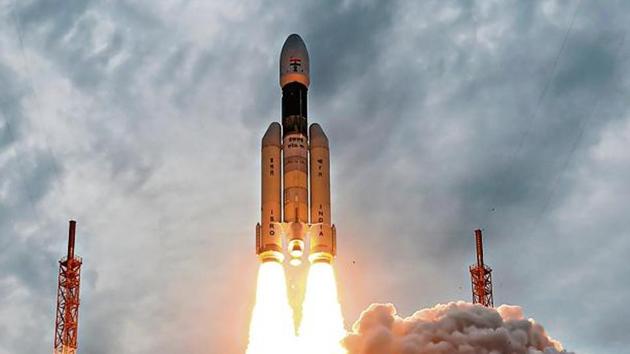Isro launches Chandrayaan-2: India shoots for the Moon
Isro is already working towards its next milestone in the first half of 2020: a solar mission called Aditya L1 to study the external layers of the sun. The Prime Minister has announced a manned space mission by 2022
India’s aim of becoming a major space powerhouse got a lift-off on Monday as it launched its second lunar mission that, if successful, will make it only the fourth country to land a spacecraft on the moon, and the first to explore its south pole.

At 2.43pm, the 14-storey-tall GSLV Mark III rocket blasted off from the Satish Dhawan Space Centre in Andhra Pradesh’s Sriharikota with the 3,850kg Chandrayaan-2 spacecraft, exactly a week after the launch was called off due to a technical snag.
“Indian at heart, Indian in spirit!” Prime Minister Narendra Modi said of the mission as anxious faces in the 7,500-strong visitor gallery and tension in the mission control room gave way to cheers and applause.
The indigenously designed spacecraft — comprising an orbiter, a lander and a rover — is expected to touch down on the moon’s surface in the early hours of the morning of September 7. The rover, called Pragyan, will examine the lunar surface, search for water, and probe craters and traps that could untangle key questions about the history of the solar system.
“Special moments that will be etched in the annals of our glorious history! The launch of Chandrayaan2 illustrates the prowess of our scientists and the determination of 130 crore Indians to scale new frontiers of science. Every Indian is immensely proud today!” tweeted Modi.
“This mission will offer new knowledge about the moon,” he added, praising Isro scientists who tweaked Chandrayaan-2’s orbit and trajectory to ensure it keeps its original date with the moon despite the launch delay.
“You found the technical glitch with alacrity and took steps to solve it. Now, within a week you achieved success in the launch. You deserve special congratulations for this,” Modi said.
“Congratulations to our scientists and engineers for furthering India’s indigenous space program,” said President Ram Nath Kovind.
Isro chairperson K Sivan said the GSLV Mark III “over-performed”, injecting the spacecraft into an orbit 6,000km higher than the intended original, giving the satellite team time and fuel for necessary manoeuvres.
“After a serious technical snag, we fixed it and bound back with flying colours,” added a beaming Sivan at the mission control room as scientists shook hands and exchanged greetings.
He heaped praise on Isro scientists who detected a leak in the rocket’s propellent system, caused by a malfunctioning valve, 56 minutes before launch on July 15, and fixed the glitch in time. “The work done in the next 24 hours to bring the vehicle back to normal was mind-boggling. It is the beginning of a historical journey of India towards the moon,” Sivan added.
The Rs 978 crore spacecraft was put in a highly elliptical orbit around the earth about 16 minutes and 14 seconds after lift-off, where it will gather velocity before being flung towards the moon after 23 days.
After a series of 15 crucial manoeuvres, the lander-rover aboard the spacecraft is scheduled to reach the lunar surface on September 7 at 02:58am.
“After that, the D-Day will come and on that day we are going to experience 15 minutes of terror, to ensure the landing is safe near the south pole,” he added.
If the landing goes successfully, India will become the fourth country after the US, the erstwhile USSR, and China to land on the moon. It will also be the first time a lander-rover will explore the south pole of the moon. It will also be the year’s third bid at a moon landing, following China’s successful launch of a lunar probe and the Israeli Beresheet spacecraft, which failed and crashed on the moon in April. The mission comes 11 years after Chandrayaan-1, which was launched on October 22, 2008 and orbited the moon at a height of 100km from the lunar surface for chemical, mineralogical and photo-geologic mapping.
“It was the instruments carried on Chandrayaan-1 that helped in discovering not only the presence of water molecules and OH [hydroxyl] molecules but also the process of formation of such molecules. We are now going to follow-up on the activities of Chandrayaan-1 with our own Chandrayaan-2, which will be enhancing what we have identified and make it more concrete both in terms of presence as well as distribution of water on the moon,” said former Isro chairman AS Kiran Kumar in a video address.
Isro is already working towards its next milestone in the first half of 2020: a solar mission called Aditya L1 to study the external layers of the sun. The Prime Minister has announced a manned space mission by 2022.
The launch also stoked a political row with the Congress crediting the country’s first prime minister, Jawaharlal Nehru, who set up the first space agency. The party also recalled Chandrayaan-2 was sanctioned by the then PM Manmohan Singh in 2008.
“This is a good time to remember the visionary move of India’s first PM Pandit Jawaharlal Nehru to fund space research,” the opposition party said in a tweet. The Bharatiya Janata Party hit back, with party spokesperson Sambit Patra accusing the Congress of politicising the issue.






